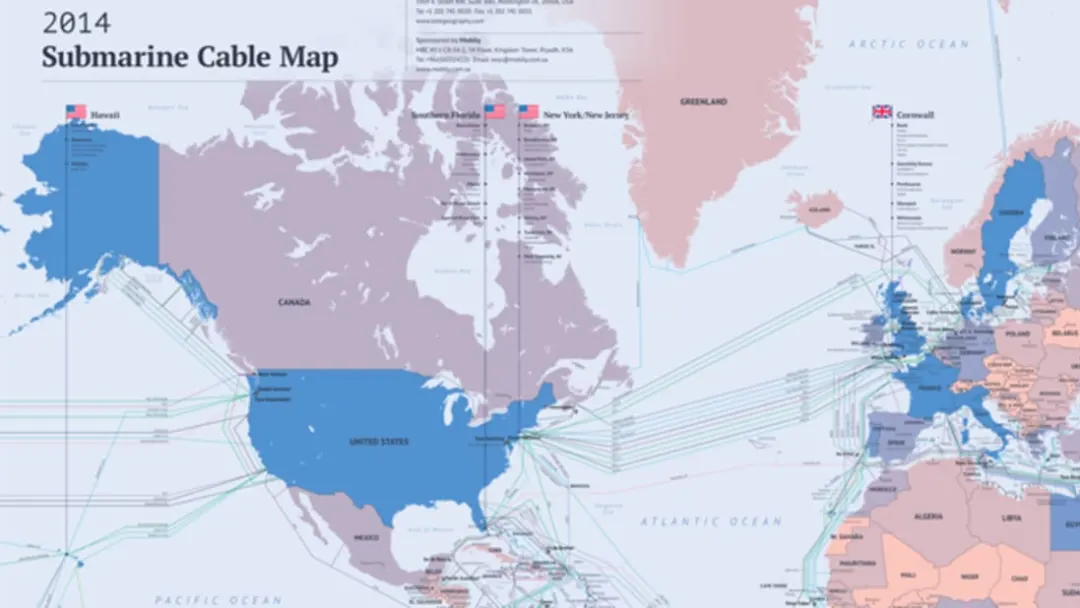Video from Morgoth's Review
Is The West An Elephant On Stilts?: Our Unhealthy & Unrealistic Dependence on the Internet
This excellent video makes a point few in the public consider.
Almost all the nations of the world are run by computers and through the worldwide web. The foundations of our connectedness to each other for a myriad of things not the least of which is financial depends on a series of underwater pipes, which contain all the cables for the internet. These cables run across a hostile ocean floor and are also available to many of our adversaries to disrupt or destroy. Have you considered this as a reality? - Andy
10 Facts About the Internet's Undersea Cables

In describing the system of wires that comprises the Internet, Neal Stephenson once compared the earth to a computer motherboard. From telephone poles suspending bundles of cable to signs posted warning of buried fiber optic lines, we are surrounded by evidence that at a basic level, the Internet is really just a spaghetti-work of really long wires. But what we see is just a small part of the physical makeup of the net. The rest of it can be found in the coldest depths of the ocean. Here are 10 things you might not know about the Internet’s system of undersea cables.
1. CABLE INSTALLATION IS SLOW, TEDIOUS, EXPENSIVE WORK.
Ninety-nine percent of international data is transmitted by wires at the bottom of the ocean called submarine communications cables. In total, they are hundreds of thousands of miles long and can be as deep as Everest Is tall. The cables are installed by special boats called cable-layers. It’s more than a matter of dropping wires with anvils attached to them—the cables must generally be run across flat surfaces of the ocean floor, and care is taken to avoid coral reefs, sunken ships, fish beds, and other ecological habitats and general obstructions. The diameter of a shallow water cable is about the same as a soda can, while deep water cables are much thinner—about the size of a Magic Marker. The size difference is related to simple vulnerability—there’s not much going on 8000 feet below sea level; consequently, there’s less need for galvanized shielding wire. Cables located at shallow depths are buried beneath the ocean floor using high pressure water jets. Though per-mile prices for installation change depending on total length and destination, running a cable across the ocean invariably costs hundreds of millions of dollars.." from the article: 10 Facts About the Internet's Undersea Cables
What Would Really Happen If Russia Attacked Undersea Internet Cables
IT MIGHT SEEM like a nightmare scenario. A terrorist organization or nefarious nation state decides to derail the global internet by faulting the undersea fiber optic cables that connect the world. These cables, which run along the ocean floor, carry almost all transoceanic digital communication, allowing you to send a Facebook message to a friend in Dubai, or receive an email from your cousin in Australia.
US Navy officials have warned for years that it would be devastating if Russia, which has been repeatedly caught snooping near the cables, were to attack them. The UK’s most senior military officer said in December that it would “immediately and potentially catastrophically” impact the economy were Russia to fault the lines. NATO is now planning to resurrect a Cold War-era command post in part to monitor Russian cable activity in the North Atlantic.
The idea of the global internet going dark because some cables were damaged is frightening. But if Russia or anyone else were to snip a handful of the garden hose-sized lines, experts say that the consequences would likely be less severe than the picture the military paints. The world’s internet infrastructure is vulnerable, but Russia doesn't present the greatest threat. There are plenty of more complicated problems, that start with understanding how the cable system actually works.
“The amount of anxiety about somebody sabotaging a single cable or multiple cables is overblown,” says Nicole Starosielski, a professor at New York University who spent six years studying internet cables to write the The Undersea Network. “If somebody knew how these systems worked and if they staged an attack in the right way, then they could disrupt the entire system. But the likelihood of that happening is very small. Most of the concerns and fears are not nearly a threat at all.”
For one, ruptures aren’t exactly an anomaly. One of the estimated 428 undersea cables worldwide is damaged every couple of days. Nearly all faults aren’t intentional. They’re caused by underwater earthquakes, rock slides, anchors, and boats. That’s not to say that humans are incapable of purposefully messing with the cables; off the coast of Vietnam in 2007, fishermen pulled up 27 miles of fiber cords, disrupting service for several months. (It wasn't cut off completely, because the country had one more cable that kept the internet going.).." from the article: What Would Really Happen If Russia Attacked Undersea Internet Cables
Can you imagine living your life day to day without the internet. For much of humanities history people did just that. Could it happen, could it fail? Yes of course. So the question then is are you tough enough, resilient enough to live without technology? perhaps you should give it some thought. - Andy
